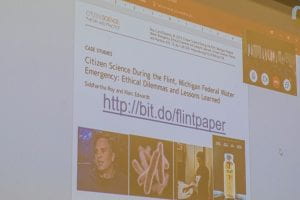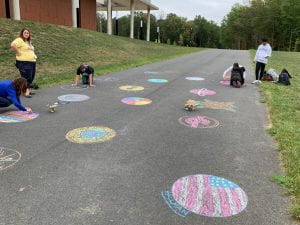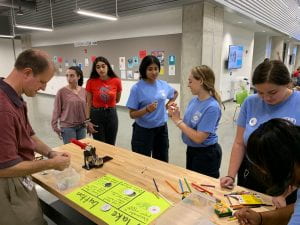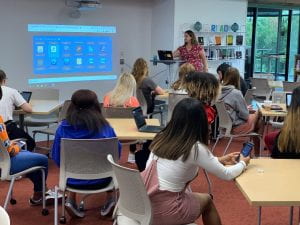On Friday, September 20th we released our Monarch Butterfly from the research library. After stopping by the plant sale, she took off to begin her migration to Mexico.
Monthly Archives: September 2019
Citizen Science: A Tale of Two Cities
“Pursue truth before everything else.” These were the parting words of Dr. Siddhartha ‘Sid’ Roy, who spoke to the AP Environmental students via Skype this Thursday about how citizen (investigative) scientists pioneered the change necessary to bring potable water to their towns.
Potable water is used for consumption. Until 1986 water was transported to our homes through lead pipes – then we discovered the dangers of lead consumption. Lead is known as the ‘silent killer,’ as it’s clear in liquid and has no odor. Despite the ban, many cities are still operating on outdated infrastructure and may continue to as long as they have acceptable lead levels (less than 15 parts per billion).
So where is the lead? In 2000, Washington DC switched the disinfectant at their water treatment plants from chlorine to chloramine. In doing so, the pipes transporting the water began to corrode. Birth rates began to decrease in DC as lead ingestion rose to beyond safe levels. It took four years (and the uncovering of many falsified papers) before a solution was reached.
The same issue occurred in Flint, Michigan. Originally, the city was purchasing its water from two outside sources (one being Lake Huron), prior to switching to the Flint River. When the switch occurred, no corrosion control measures were put in place and huge amounts of lead were released into the drinking water. After much sampling, protesting, and reporting, President Obama declared a federal emergency for Flint in 2016 and the city switched the water supply back to Lake Huron. Citizen scientists saved the day again! So why is Flint still in a water crisis?
It’s not. According to Dr. Roy, Flint, Michigan has some of the safest drinking water around. It’s us who are in the dark ages. Since 2016, Michigan has waged a war on lead, holding their water quality to stricter standards and more frequent sampling. So why are we still trying to save Flint?
“You can’t just put on the advocacy hat,” Dr. Roy states. “You actually have to be an expert.”
Flint’s source of water is currently one of the largest sources of fake news in the media.
This is a good lesson for us all. Before you advocate ( share, click, like ), always verify what you are sharing is true.Keep your emotions in check. For this reason, our research library has made this the first move in Michael Caulfield’s “Four Move” method for information evaluation.
Want to take the charge? Cities like Newark, NJ and Chicago, IL are currently facing lead issues.
Want to read more? Check out http://bit.do/flintpaper
32nd ANNUAL LEESBURG CAR SHOW
INTERNATIONAL DOT DAY
HAPPY INTERNATIONAL DOT DAY (September 15th)!
Based on Peter H. Reynolds’ book The Dot about a caring teacher who dares a doubting student to trust in her own abilities and “make her mark,” DOT DAY is a celebration of creativity, courage and collaboration! Click here for a 4 minute narrated version of The Dot.
Mr. Malone, Mr. Lear and Mr. Ajima joined forces to design a conic sections demonstrator from 2 large plywood dots.
Students rose to the challenge to be creative and design their own dots.
Congratulations to Mr. Coates & His Masonry Classes
Research Library Orientation
The Periodic Table Upended
By Ms. Roberts
The periodic table of elements has served the field of chemistry well for 150 years, but there are other options out there. Some scientists are now pushing its limits.
Devised in 1869 by the Russian chemist Dmitri Mendeleev, the periodic chart is a 2-dimensional array of chemical elements ordered by atomic number and arranged 18 across by orbitals. It is considered one of the most important achievements in modern science. The schema of patterns and trends enables scientists to predict elemental properties, reactivities, and even new elements. The position of an element in the table can reveal a lot of things about it, such as whether it’s metal or not or if it’s abundant on earth or not. This original form has remained largely unchanged for the past 150 years, except for the addition of new elements that have been discovered, although generations of chemists have made attempts to improve it or just make it more fun.
Recently, in the May issue of Nature Chemistry, a group of chemists and psychologists at British universities proposed turning the periodic table on its head. They asserted that rotating it 180 degrees about a horizontal axis would make it more like a traditional graph so that values increase from bottom to top. Most of the properties would then increase from bottom to top, including atomic number, atomic mass, atomic radius, maximum oxidation state and reactivity. Despite the inversion, each element still has all of the same neighbors that it had before, only now the chart shows the elements proceeding upwards as they gathered atomic weight and complexity. This new form might be easier for chemistry students to interpret and understand.
On another note, have you ever read The Periodic Table by Primo Levi? Published in Italy in 1975, it’s a collection of 21 autobiographical stories that each use a chemical element as a starting point, covering everything from Levi’s childhood and education and his work as a professional chemist to his life in and after Auschwitz. It was in fact chemistry that helped him survive the Holocaust. Because he was a trained chemist, he was deemed valuable enough to be slave labor for a German rubber factory. It became a critical and commercial success when the first American version was published in 1984, and in 2006, The Periodic Table was listed by London’s Royal Institution as among the best science books ever written.
































